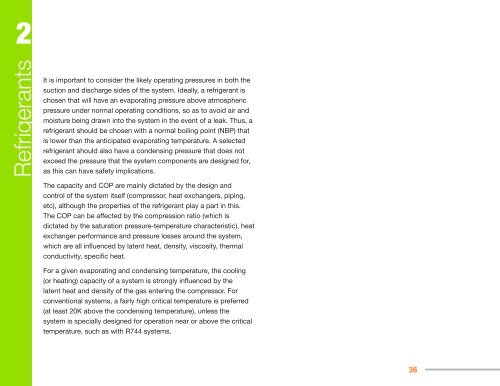Manual for Refrigeration Servicing Technicians - UNEP - Division of ...
Manual for Refrigeration Servicing Technicians - UNEP - Division of ...
Manual for Refrigeration Servicing Technicians - UNEP - Division of ...
You also want an ePaper? Increase the reach of your titles
YUMPU automatically turns print PDFs into web optimized ePapers that Google loves.
2<br />
Refrigerants<br />
It is important to consider the likely operating pressures in both the<br />
suction and discharge sides <strong>of</strong> the system. Ideally, a refrigerant is<br />
chosen that will have an evaporating pressure above atmospheric<br />
pressure under normal operating conditions, so as to avoid air and<br />
moisture being drawn into the system in the event <strong>of</strong> a leak. Thus, a<br />
refrigerant should be chosen with a normal boiling point (NBP) that<br />
is lower than the anticipated evaporating temperature. A selected<br />
refrigerant should also have a condensing pressure that does not<br />
exceed the pressure that the system components are designed <strong>for</strong>,<br />
as this can have safety implications.<br />
The capacity and COP are mainly dictated by the design and<br />
control <strong>of</strong> the system itself (compressor, heat exchangers, piping,<br />
etc), although the properties <strong>of</strong> the refrigerant play a part in this.<br />
The COP can be affected by the compression ratio (which is<br />
dictated by the saturation pressure-temperature characteristic), heat<br />
exchanger per<strong>for</strong>mance and pressure losses around the system,<br />
which are all influenced by latent heat, density, viscosity, thermal<br />
conductivity, specific heat.<br />
For a given evaporating and condensing temperature, the cooling<br />
(or heating) capacity <strong>of</strong> a system is strongly influenced by the<br />
latent heat and density <strong>of</strong> the gas entering the compressor. For<br />
conventional systems, a fairly high critical temperature is preferred<br />
(at least 20K above the condensing temperature), unless the<br />
system is specially designed <strong>for</strong> operation near or above the critical<br />
temperature, such as with R744 systems.<br />
36

















